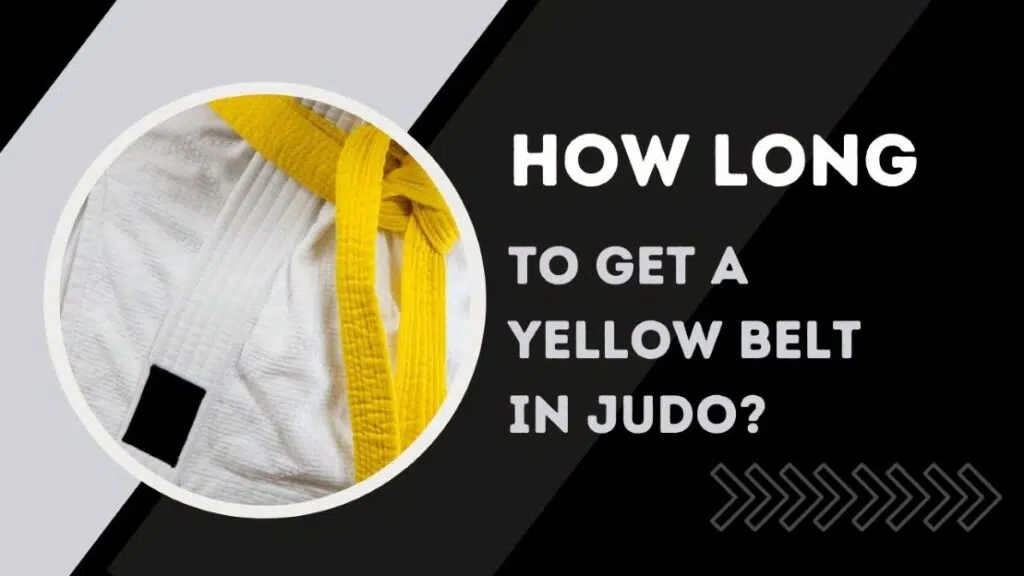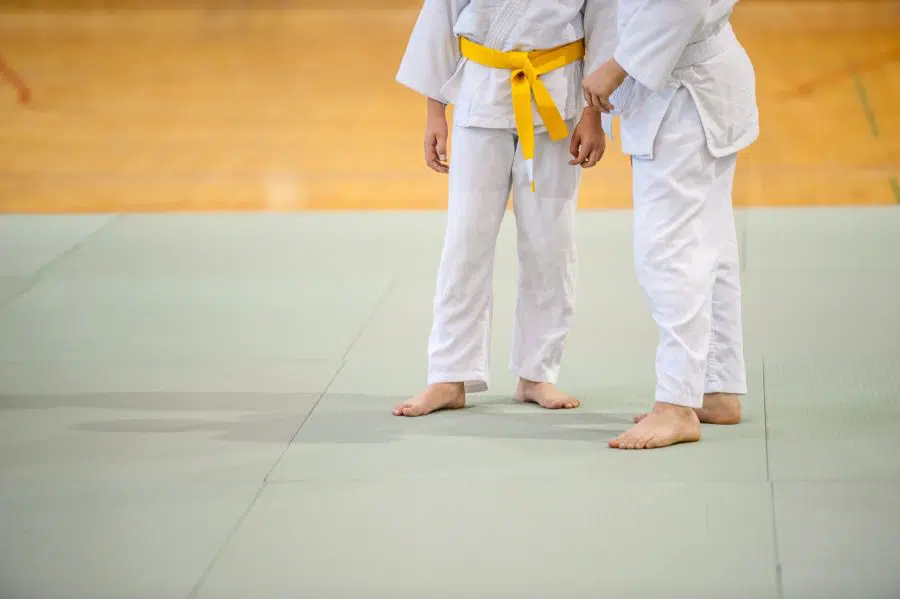Some martial arts have a belt system that provides a measure of progress for students. Judo is a very popular martial art that is very focused on throwing and grappling techniques. Today, I will explain the requirements to go from white belt to yellow belt in judo and how long it takes.
On average it takes 2 months or 15 classes to get a yellow belt in judo under the United States Judo Association (USJA) system. But, the requirements do differ based on country and instructor. For example, in Canada, it takes 30 classes to get a yellow belt in judo for those over 17 years of age.
In this article, I will explain what techniques a yellow belt needs to know, how the number of classes differs for juniors (those under 17), and for seniors (those over 17), as well as, how long it takes to get each belt in judo.

How Do You Get a Yellow Belt in Judo
The good thing about judo is that there are a set number of techniques that you need to learn. And virtually all schools have the same curriculum.
There is generally a time requirement of anywhere between 15 to 30 classes for seniors, and sometimes as many as 60 classes for juniors.
It does vary based on country.
For example, in the USA both juniors and seniors need to complete 15 classes, as well as demonstrate the ability to perform a set of techniques. Whereas in Canada juniors are required to do 60 classes, and seniors need to do 30 classes.
The exact curriculum of techniques can vary a little bit, but in general, it involves 12 techniques.
Here’s an example curriculum from a judo school that shows a list of the techniques a judoka – the Japanese word for a person who does judo – needs to know:
| Throwing techniques | Ground techniques |
| Advanced foot sweep | Scarf hold |
| Knee wheel | Side for quarters hold |
| Propping drawing ankle | Shoulder hold |
| Floating hip | Upper four quarters hold |
| Major outer reap | – |
| Major hip | – |
| Major inner reap | – |
| Shoulder throw (1 or 2 armed) | – |
These techniques don’t have very descriptive names so below I’ve included the Japanese names for the techniques, that way you can watch the videos of each of the techniques on this page of the official Kodokan website to see what they look like:
| Throwing techniques | Ground techniques |
| Deashi-harai | Kesa-gatame |
| Hiza-guruma | Yokoshito-gatame |
| Sasae-tsurikomi-ashi | Kata-gatame |
| Uki-goshi | Kami shiho-gatame |
| O-soto-gari | – |
| O-goshi | – |
| O-uchi-gari | – |
| Seoi-nage | – |
Here’s also a video that shows all of the techniques that a student needs to know to get a yellow belt in judo.
However, there can be a few techniques less in the test or a few more techniques, depending on your individual instructor:
Jigoro Kano put all of the techniques into a curriculum under the first judo school in the early 1800s. He also developed the values or ethics of judo.
His teachings are now administered via the Kodokan Judo Institute in Tokyo, Japan.
Currently, they have a full description of all of the techniques in judo, as well as, short very well-produced videos of each of the techniques.
The techniques are not difficult. However, they do require precise execution and are somewhat physically demanding. Especially if you don’t do other sports.
The yellow belt is the first belt that a person gets awarded. When a person first begins training in judo they are a white belt even if they don’t have any previous training.
Interestingly the techniques in judo come from another martial art known as jiu-jitsu.
Judo comes from jiu jitsu the unarmed fighting style of the samurai
Judo is a shortened version of the word ju-do.
There are various different spellings of judo in English. For example, it can be spelled jiu-do.
Judo was originally a set of martial arts techniques that were called jiu-jitsu. This was the unarmed fighting style used by the samurai in Japan.
It was primarily used by the military forces in Japan. It was taught along with bow and arrow, sword, knife, and other weapons fighting systems.
In the history of Japan, weapons were banned for a time. Therefore, the only martial arts people could train was the unarmed fighting style known as jiu-jitsu. It had other spellings and names in English such as ju-jutsu, and ju-jitsu.
It became unpopular for a time, during a time of relative peace in Japan.
But, there were many people who still enjoyed and liked to train it. Jigoro Kano who is the ‘inventor’ of judo changed the focus of jiu-jitsu from a form of fighting for war, and instead into a form of training for spiritual and moral empowerment.
Who invented the colored belt ranking system, and also added a code of ethics.
As part of adapting jiu-jitsu he renamed it to jiu-do or ju-do. Which is now spelled judo. This was done to reflect the change of its focus from a combat art for war to one of spiritual and moral empowerment and personal development.

Is a Yellow Belt in Judo Good?
The yellow belt is the first belt in judo, and it generally takes less than 6 months to get it. Over this time the yellow belt has spent quite a bit of time practicing each of the techniques.
But, how good is a yellow belt in judo?
A yellow belt in judo can generally execute throws and pins on a resisting person. In attempting to throw an opponent a yellow belt won’t be successful every single time. However, they can competently execute the techniques when their opponent is trying to avoid it or execute their own throws.
Here’s a video of a judo tournament where two junior yellow belts are competing. In a tournament, participants don’t wear their colored belts.
But, instead, wear a belt to make it easy to distinguish them from one another. So, in the video you will notice they aren’t wearing a yellow belt:
As you can see the yellow belt match looks very similar to a wrestling match. However, it’s also possible to apply submission holds which aren’t allowed in all types of wrestling.
The other major difference is the use of the gi jacket which provides handles for competitors to move the arms and control the upper body to make it easier to execute a throw or sweep/trip.
How Long Does Each Belt Take in Judo?
The colored belt ranking system was first used in judo. But, now it’s used in a lot of different martial arts.
It’s generally understood that getting a black belt takes quite a long time but how long does it take to go from one belt to the next in judo?
It takes on average 2 years to go from one belt to the next. But, the first few belts take quite a bit less time. To go from white to yellow takes 3 to 4 months, then another 6 months to 12 months to go from yellow to orange. Each belt after that takes around 2 to 3 years each.
Here’s a table that shows this info:
| Belt | Time at this belt | Cumulative time |
| White | 3 to 4 months | 3 to 4 months |
| Yellow | 6 to 12 months | 1 year to 1.5 years |
| Orange | 1 to 2 years | 2 years to 3.5 years |
| Green | 2 to 3 years | 4 years to 6.5 years |
| Blue | 3 to 4 years | 7 years to 10.4 years |
| Brown | 2 years | 9 years to 12.4 years |
| Black | – | – |
The exact time it takes largely depends on the discretion of your instructor, and how strict or lax they are in how well you need to execute the moves.
For example, if your instructor prefers their students to have a higher level of skill in each move it can take longer for them to promote you to the next belt.
As you can see it takes about 10 years to get a black belt in judo. I explained the details about how a black belt is awarded in judo in this article about how long it takes to get a black belt in judo.
It explains how the grading is done, and what a person is required to know and demonstrate to be awarded a black belt in judo.
As well as, the belts that come after black belt, and how each of the different degrees on a black belt are awarded.
